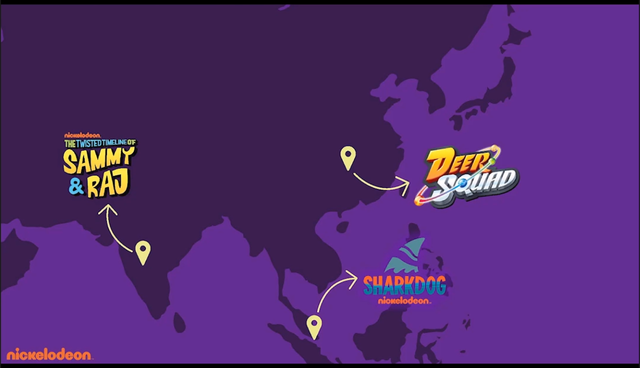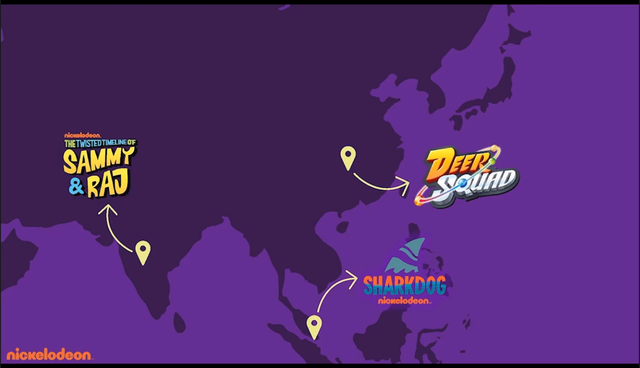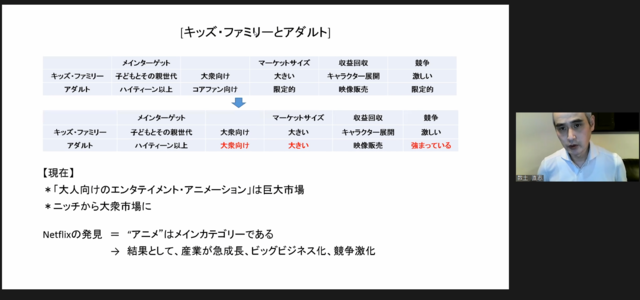The Tokyo Metropolitan Government has started the “Overseas Advancement Step-up Program” again this year as an opportunity to learn business knowledge and skills in order to support overseas advancements of animation-related businesses in Tokyo.
The online program consists of six sessions, four seminars and two workshops, and will continue on to the “Tokyo Animation Pitch Grand Prix” in February 2022.
The first seminar, “Seminar A: Introductory Session,” was held on September 24 and focused on the theme of “Overseas Development under the Covid-19 situation.
The speakers were Sudo Tadashi, who established the anime information website “Anime! Anime!” in 2004 and is now an independent journalist engaged in reporting and writing about animation, Imata Susumu, President and Representative Director at ViacomCBS Networks Japan G.K. and Chris Rose, head of the internal and external animation development and production teams at Nickelodeon International and VIS KIDS.
Here is a report on the seminar, where they discussed the current position of Japanese animation in the world and what kind of animation works are accepted internationally.
With the expansion of overseas markets, the Japanese animation industry is “leading by one or two lengths.”
The first speaker was animation journalist Sudo. He talked about the current situation of the animation industry in Japan and abroad under the theme of “Overseas Animation Market in the New Era: How has it changed since the Covid-19?”
First of all, Sudo introduced the current situation of the domestic animation industry, which has recorded a growth rate of 128% over the past 20 years, and the reason behind this is the overseas market. Speaking about the fact that it is difficult to realize the growth in Japan, he stated that “in terms of a number of people, more than half of the viewers of Japanese anime are overseas,” as the licensing business in overseas markets, such as distribution rights for streaming services, is major support.
However, among the growing overseas markets, the situation is changing in the Chinese market, where the growth is becoming smaller due to the tightening of regulations on expression and the elimination of competition in buying video distribution platforms due to oligopoly. He analyzed that the reason for the continued growth is due to sales related to game licensing and the influence of emerging markets such as the Middle East, Southeast Asia, and Central and South America, which were not previously associated with the market, and in addition to buying programs, there has been an increase in the number of cases where programs have been picked up by “Hollywood majors,” such as production investment, anime adaptations in their own countries, and live-action films.
While the market is expanding in this way, there is clearly a shortage of animation production companies, and more and more animation is being produced by foreign studios. However, there is still a high demand for domestic brand-name studios that have established stable quality and popularity, and Sudo predicted that “companies that can produce high-quality animation will be in a better position and will be able to negotiate more aggressively.”
From here, the topic shifted to “What is the overseas business of animation?” He spoke about the importance of considering what fields you are good at and what you can do, especially under the Covid-19 situation, and introduced “five ways to find business partners overseas.”
The five methods are: “1. Personal dealings (connections/introductions),” “2. Overseas film markets (international trade fairs),” “3. Domestic trade fairs, 4. Seminars/Matching events/Business tours,” and “5. Anime/Comic conventions.” Of these, personal dealings that have already gained a sense of trust are highly attractive, but difficult for newcomers to enter the industry, and the most effective way to acquire new business partners is through “2. Overseas film markets (international trade fairs).”
Turning to the overseas animation industry, he introduced, although it is difficult to compare simple figures, there is no doubt that it continues to expand globally, and the influence of video distribution platforms, in particular, is remarkable. In the past, anime fans of the adult generation were considered the core layer, but now they tend to prefer popular works, and it seems that it is changing to “adults also enjoy anime as entertainment.”
The strength of Japanese animation in such a situation where foreign animation is gaining momentum lies in the simple power of the original work, which continues to produce highly recognized global IP, and the established business model of marketing to fans. Although the situation that could be called a monopoly is already crumbling, Sudo described the current situation as “leading by one or two lengths.”
At the end of the session, he mentioned the impact of the Covid-19 on the animation industry. Although production delays have almost returned to normal, the postponement of movie releases and broadcasts has been occurring and is affecting promotions. He said that the most affected area was the event and live performance industry, which had been a very growing field in the past few years, and that it must have been hit hard.
International trade fairs are still being postponed or canceled one after another, and there is a great possibility that business opportunities that would have been created through face-to-face meetings are being lost when they are held virtually. At the same time, however, there are some advantages that only online can offer, such as reduced participation costs and increased opportunities, and Sudo predicted that “virtual trade shows” will remain even after the effects of Covid-19 have subsided.
Based on this, he concluded his lecture by saying that we need to look into the development of businesses that utilize online as well as trade fairs.
What are the “three pillars” that make Nickelodeon’s work resonate internationally?
The next session was about “the development and pitch of your works and projects. Let’s take a look at animation with Nickelodeon”. First, Imata Susumu, President and Representative Director of ViacomCBS Networks Japan, appeared as a speaker.
He introduced the brand of ViacomCBS Networks, which has a total of 4.2 billion households, 44 languages in 184 countries, and 1.7 billion social fans. In addition to the terrestrial broadcast of “SpongeBob”, one of the representative works in Japan, and its development through VOD and online TV, it was also mentioned that the “Nickelodeon” brand introduced this time is a channel that targets a wide range of children from preschoolers to school children.
Chris Rose, head of the animation development and production teams both inside and outside of Nickelodeon International and VIS KIDS, appeared on the recorded video to talk about the concept and background of the brand’s many innovative and global works.
Chris began by describing how reflecting the world of children, their primary target audience, in their productions “has been and always will be essential to their content,” and that they are constantly doing research to stay true to that mission. Children want their TV shows to reflect who they are, so they are focusing on making sure that everyone can be replaced by diverse content.
He also introduced a number of guidelines for their approach when creating content, such as the fact that Nickelodeon has already been a successful TV animation brand for over 40 years, but now they are conscious of developing their content on multiple platforms at the same time, such as online streaming, to meet their needs.
Nickelodeon has been collaborating with kids’ content creators around the world to significantly evolve its model. Policies for original series are in place on each continent, and we will focus on three ongoing series in Asia, “DEER SQUAD,” “The Twisted Timeline of Sammy & Raj,” and “SHARKDOG,” as great examples of productions that succeed globally while collaborating with local partners.
The first film introduced was “DEER SQUAD,” a scenario written in England and produced by a Chinese studio. The four deer characters in the film were originally popular mascots, but evolved from the idea that they could be the stars of an animated TV show. One of the features of this work is that it has a deeper scenario than the usual works for preschoolers, where the universal composition of “good and evil” leads to learning about social feelings and awareness of environmental issues.
The next topic was “The Twisted Timeline of Sammy & Raj,” which is based on an idea from an intern at Nickelodeon India and is scheduled to air in 2022. There are a huge number of studios in India, and this was introduced as a promising work to prove that India can produce world-class works. The outline of the work is a slapstick drama about two boys who get an app to manipulate time, but the app is just a trigger for the story, and the main theme is designed to be familiar to children, such as “family connections.”
Chris, the head writer, and the animators attended a creative workshop in Mumbai to share the same vision for the film, and they were able to create a story that is easy to relate to for children all over the world, with a child as the main character, while mixing elements that are popular in India, such as a three-generation family and humorous slapstick.
The last one is “SHARKDOG,” developed in collaboration with a Singaporean studio and streamed by Netflix. 10-year-old Max meets a creature that is half canine and half shark, with the script written in the US and the animation and storyboarding done in Singapore. Chris had high hopes for this innovative take on the traditional pet story, describing it as “a comical sensibility that everyone around the world can relate to, which is exactly what Nickelodeon is looking for.”
According to Chris, the characteristics of these Nickelodeon productions are that they are “child-friendly and appear universal based on children’s lives and experiences.” He also introduced the three pillars that Nickelodeon always talks about when developing a script: “Broad,” “Simple,” and “Emotional.”
“Broad” refers to content that has universal appeal to all viewers, such as slapstick comedy and fun characters. “Simple” means that the premise can be easily explained, such as what makes it unique, real-life issues that children can relate to, or a happy ending. And “Emotional” includes not only friendship, teamwork, and character interaction, but also the viewer’s interaction with the characters.
At the end of the session, Chris answered questions that were sent in beforehand, and introduced some important points to consider when promoting your idea. He concluded the seminar by saying that he is always looking forward to exciting ideas to create Nickelodeon content together.
Upcoming seminars
The “Overseas Expansion Step-up Program” is a program to learn the skills necessary for overseas expansion. The third seminar will be held on October 29 and the fourth on November 10.
Workshops are also scheduled to be held on November 25 and November 30. You can participate in each session by applying through the website up to two business days in advance, and the cost is free.












